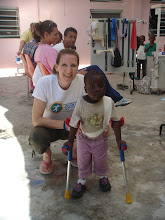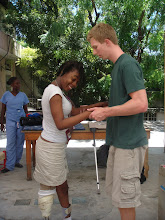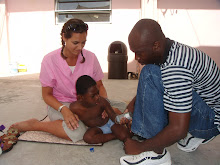We often feel that when we
created Global Therapy Group and a clinic, it was as if we dropped a stone in a pond and
the ripples it sent out still continue. Some of the ripples are:
Our 3
translators were all at the top of their classes in high school. (Which is why
their English was so good and we hired them!) They told us they never dreamed
they would be able to afford to attend college, but after being employed with
us regularly for one year, that impossible dream became a reality. Emmanuel is
studying to be a lab technician, Alex an accountant, and Andrew a PT. Andrew so impressed all the volunteers who have
worked with him, that several came back to the US and helped him apply for and
receive a full ride scholarship to a PT Assistant program at St. Catherine
University in Minnesota. Andrew ‘s dream is to return to Haiti and become the
administrator of our clinic. Andrew’s parents both died several years ago and
he and his siblings are being raised by extended family. His dream includes
providing for his brothers and sisters and perhaps allowing them to attend
college as well.
Each of the
volunteers who has traveled to Haiti and worked at the clinic tell us the
experience was one of the most meaningful in their lives and that it changed
them forever. Many return to Haiti
yearly now to assist at the clinic. Others tell us they went back to their
communities in the US and found ways to connect there and impact those in need.
They tell us Haiti completely changes your perspective. Little things like
putting a bottle of shampoo in a shopping cart and realizing it costs more than
the daily wage for our translators shifts your reality. And that’s a good
thing!
One
volunteer returned home and told her Haiti story to the daughter of a neighbor
who happened to be a PT. She was so inspired that when she and her husband
marry this summer, they will travel to Haiti to volunteer instead of taking the
traditional honeymoon.
One group of
therapists asked the half dozen elementary school age children who hung around
the clinic each day why they were not in school. When they learned that after
the earthquake their families could no longer afford the tuition, the
volunteers went to the school and paid all fees for the next 3 years for ALL of
them.
When another
group of therapists asked Andrew why he never smiled fully, they learned he was
embarrassed by his front teeth that were filled with cavities and brown. They found a dentist and paid for treatment
over the next year to restore Andrew’s beautiful smile. Whenever we see him
laugh and smile fully now we feel so happy!
One
volunteer is a professor at the University of
Georgia. She recognized the need for a real PT school in Haiti, not just
a Technician program. We connected her with the Dean of the Quisqueya
University Medical School who also has the same dream. We often feel like a conduit, connecting
people to Haiti.
A volunteer
who is a professor at Boston University PT school has her students fundraising
for us each year and has her students create education materials for us as part
of their course work.
When we
arrived and began treating patients in April 2010, none of the patients had
ever heard of “Physio Therapy." Now it is a term know in the community of
Port au Prince and patients arrive asking for this service.
Jo Ann and I have many “If we did
nothing else in Haiti, we………. stories.”
Clifford was a 3 year old at the
time of the earthquake who had his right leg amputated above the knee after
being injured. Mom brought him to the
hospital due to small blister on his remaining stump, as she was concerned
about infection. Clifford had been crawling or she would carry him since his
surgery, as she had no idea what therapy was or that any options were possible.
We gave him his first pair of tiny crutches that day and watched as he
delighted in hopping all over our clinic on his one foot. When we learned on his next visit that he was
not walking at home as the rocks hurt his left foot, we gave him a shoe. The next visit when he had cold symptoms, we
learned he and his 5 brothers and sisters slept out in the open each night as
they did not have a tent or even a tarp. “And he gets wet and cold when it
rains” his mom said. One of the
volunteers took her own money and bought the family a tarp. Over the next year
we had Clifford fitted with his first prosthesis and taught him to play soccer.
Judeline was 15 at the time of
the earthquake and was trapped when her family’s third floor apartment
collapsed. She had her right leg amputated, her left lower leg was crushed and
had nerve damage, and her left hand and wrist were crushed also needing
surgery. When we met Judeline she was lying in bed all day and would not rise
even for toileting. Her left hand and arm were so stiff and sensitive that she
refused to allow anyone to touch them. She was so traumatized, she would not
look us in the eyes or smile. With much encouragement, tough love, and
perseverance, we were able to teach Judeline to transfer herself from the bed
to a wheelchair that first month, and she began to wheel herself all over the
hospital. The next month we taught her to walk with a new prosthesis and a
walker, and after a few months she could do that on her own. We began hand
therapy that was extremely painful for her, but bribed her with I-pod time,
candy, magazines, and the attention of handsome young men. After many months
the hand was less sensitive and the fingers began to work again. We contacted
her original hand surgeon and he arranged for her to come to the US for more
surgery so her hand could recover fully. When she arrived it was decided no
further surgery was needed due to the extensive therapy she had received at our
clinic in Haiti. One year after her injury we taught her to walk with only a cane,
and to dance again. Now, two years after her injury, she is walking all over
Port au Prince without any assist and most people do not even realize she has a
prosthetic leg. She is attending high school, uses her left hand again, and
smiles often.
Anise was 6 months pregnant when
she was injured in the earthquake and had her leg amputated. She was fitted
with a prosthesis, but when we met her in April, she was unable to wear it due
to swelling from the pregnancy and was ready to deliver her baby. When Iaasc was
born, Anise did not seem to bond with
him, perhaps due to her trauma since the earthquake. This was her first baby
and she had no family with her to teach her how to feed or care for him. He weighed
less than 5# when he was born, and started to lose weight that first week. The
hospital started an IV and Anise then believed that provided all his
nourishment and stopped feeding him. He was soon too weak to even cry and
became limp. We stepped in and educated Anise and her husband about nursing,
stimulating and caring for a newborn baby.
Soon he was a strong baby boy again. Anise could not carry and care for
a baby while walking with two crutches however. So we taught her to use only
one and then none.
Nursing Training: Many of the
bedbound patients we saw within the hospital had terrible bed sores from lying
in one position since their injury three months before we arrived. We organized
an inservice for the nurses and educated them about turning patients every 2
hours to prevent skin breakdown. Such a
simple thing, but the idea was unknown to the hospital staff. The nurses immediately began to teach this
technique to families and soon, few bed sores were found. We found the Haitians
so eager to learn new things and were amazed how quickly they embraced new ways
of doing things or techniques. People in
the US are usually much more resistant!
Because our clinic was there:
Children with amputations who had
been hopping on one foot or carried by parents since their injury, were given
crutches or a wheelchair and returned to being independent. We arranged for many to be fitted with a prosthesis
and then taught them to walk again unaided.
Parents who had children with
developmental disabilities had a chance for the first time to learn that more
normal movement, walking and hand function was possible with regular exercise.
Children learned swallowing techniques and could drink without choking and
control their drooling throughout the day.
Parents of babies learned how to
monitor for dehydration and the steps to take to rehydrate before the infant
became ill.
Many people learned about cholera
and prevention techniques.
High blood pressure was
recognized in MANY people and education given to prevent a stroke.
Many patients who had problems causing pain
that they had lived with for years, were “cured” after just a few treatments
and returned to a life free from pain and limitations.
**A woman with a pelvic
dislocation after a difficult birth 10 years ago had lived with weakness and
pain in her legs. After just 3 PT sessions her pain was gone and she no longer
needed a cane to walk.
**A man came to us one year after
the earthquake with severe nerve pain in his lower leg after a crush injury.
After two weeks of PT, his pain was gone.
**Many people with crush injuries
of the hands and ankles from the earthquake came to us with hands and feet that
were immobile. Many men were unable to work as their hands could not move or
grip. After therapy at the clinic, they began moving more normally and were
able to return to work.
**The best thing about treating
patients in Haiti is that they follow our instructions and comply fully with our
exercise programs. They return, feeling stronger, and are so excited. They tell
us, “I am better! Please teach me more.” In the US we have more difficulty
getting patients to comply. No one wants to work that hard it seems. When you
have to work in order to eat each day, it seems to motivate people more!
























